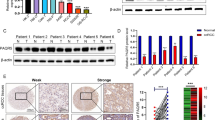Summary
This study examined the possible role of p120ctn in the pathogenesis and development of pancreatic cancer. PANC-1 cells, a kind of human pancreatic carcinoma cell line, were cultured in this study. p120ctn was immunocytochemically detected in PANC-1 cells. The recombinant lentivirus vector was constructed to knock down the p120ctn expression of PANC-1 cells. Real-time quantitative PCR (RQ-PCR) and Western blotting were used to determine the expression of p120ctn and E-cadherin in PANC-1 cells after p120ctn knockdown. The adhesion, invasion and migration capacity of PANC-1 cells after p120ctn knockdown was detected by cell adhesion, invasion and migration assays. Cell growth was measured by the MTT method. Cell cycle and apoptosis were analyzed by fluorescence-activated cell sorting. The results showed that p120ctn knockdown led to significantly down-regulated E-cadherin and a reduced cell-to-cell adhesion ability in PANC-1 cells. shRNA-mediated knockdown of p120ctn reduced invasion and migration capacity of PANC-1 cells, inhibited cell growth, caused a significant decrease in the percentage of cells in G1, an increase in S, and promoted apoptosis of PANC-1 cells. It was concluded that p120ctn plays a pivotal role in the proliferation and metastasis of pancreatic carcinoma, suggesting that p120ctn is a novel target for pancreatic carcinoma treatment.
Similar content being viewed by others
References
Parkin DM, Bray F, Ferlay J, et al. Global cancer statistics, 2002. CA Cancer J Clin, 2005,55(2):74–108
van den Brandt PA, Goldbohm RA. Nutrition in the prevention of gastrointestinal cancer. Best Pract Res Clin Gastroenterol, 2006,20(3):589–603
Kern S, Hruban R, Hollingsworth MA, et al. A white paper: the product of a pancreas cancer think tank. Cancer Res, 2001,61(12):4923–4932
Wijnhoven BP, Dinjens WN, Pignatelli M. E-cadherin-catenin cell-cell adhesion complex and human cancer. Br J Surg, 2000,87(8):992–1005
Kanner SB, Reynolds AB, Parsons JT. Tyrosine phosphorylation of a 120-kilodalton pp60src substrate upon epidermal growth factor and platelet-derived growth factor receptor stimulation and in polyomavirus middle-T-antigen-transformed cells. Mol Cell Biol, 1991,11(2):713–720
Staddon JM, Smales C, Schulze C, et al. p120, a p120-related protein (p100), and the cadherin/catenin complex. J Cell Biol, 1995,130(2):369–381
Reynolds AB, Daniel J, McCrea PD, et al. Identification of a new catenin: the tyrosine kinase substrate p120cas associates with E-cadherin complexes. Mol Cell Biol, 1994,14(12):8333–8342
Liu Y, Li QC, Miao Y, et al. Ablation of p120-catenin enhances invasion and metastasis of human lung cancer cells. Cancer Sci, 2009,100(3):441–448
Bellovin DI, Bates RC, Muzikansky A, et al. Altered localization of p120 catenin during epithelial to mesenchymal transition of colon carcinoma is prognostic for aggressive disease. Cancer Res, 2005,65(23):10938–10945
Wijnhoven BP, Pignatelli M, Dinjens WN, et al. Reduced p120ctn expression correlates with poor survival in patients with adenocarcinoma of the gastroesophageal junction. J Surg Oncol, 2005,92(2):116–123
Mayerle J, Friess H, Buchler MW, et al. Up-regulation, nuclear import, and tumor growth stimulation of the adhesion protein p120 in pancreatic cancer. Gastroenterology, 2003,124(4):949–960
Seidel B, Braeg S, Adler G, et al. E- and N-cadherin differ with respect to their associated p120ctn isoforms and their ability to suppress invasive growth in pancreatic cancer cells. Oncogene, 2004, 23(32):5532–5542
Shi-bo L, Zhang-jun C, Xin S, et al. Construction and identification of recombinant lentiviral vector expressing shRNA of p120 catenin gene. Acad J Sec Mil Med Univ, 2010,31:553–557
DiMagno EP, Reber HA, Tempero MA. AGA technical review on the epidemiology, diagnosis, and treatment of pancreatic ductal adenocarcinoma. American Gastroenterological Association. Gastroenterology, 1999, 117(6):1464–1484
Paschos KA, Canovas D, Bird NC. The role of cell adhesion molecules in the progression of colorectal cancer and the development of liver metastasis. Cell Signal, 2009,21(5):665–674
Thoreson MA, Reynolds AB. Altered expression of the catenin p120 in human cancer: implications for tumor progression. Differentiation, 2002,70(9–10):583–589
Yanagisawa M, Huveldt D, Kreinest P, et al. A p120 catenin isoform switch affects Rho activity, induces tumor cell invasion, and predicts metastatic disease. J Biol Chem, 2008,283(26):18344–18354
Liu Y, Xu HT, Dai SD, et al. Reduction of p120(ctn) isoforms 1 and 3 is significantly associated with metastatic progression of human lung cancer. APMIS, 2007,115(7):848–856
Kardash E, Reichman-Fried M, Maitre JL, et al. A role for Rho GTPases and cell-cell adhesion in single-cell motility in vivo. Nat Cell Biol, 2010, 12(1):47–53; sup pp 1–11
Cavallaro U, Christofori G. Cell adhesion in tumor invasion and metastasis: loss of the glue is not enough. Biochim Biophys Acta, 2001, 1552(1):39–45
Ireton RC, Davis MA, van Hengel J, et al. A novel role for p120 catenin in E-cadherin function. J Cell Biol, 2002, 159(3):465–476
Nobes CD, Hall A. Rho GTPases control polarity, protrusion, and adhesion during cell movement. J Cell Biol, 1999, 144(6):1235–1244
Grosheva I, Shtutman M, Elbaum M, et al. p120 catenin affects cell motility via modulation of activity of Rho-family GTPases: a link between cell-cell contact formation and regulation of cell locomotion. J Cell Sci, 2001,114(Pt 4):695–707
Yap AS, Kovacs EM. Direct cadherin-activated cell signaling: a view from the plasma membrane. J Cell Biol, 2003,160(1):11–16
Nong CZ, Pan LL, He WS, et al. P120ctn overexpression enhances beta-catenin-E-cadherin binding and down regulates expression of survivin and cyclin D1 in BEL-7404 hepatoma cells. World J Gastroenterol, 2006,12(8):1187–1191
Soto E, Yanagisawa M, Marlow LA, et al. p120 catenin induces opposing effects on tumor cell growth depending on E-cadherin expression. J Cell Biol, 2008,183(4): 737–749
Author information
Authors and Affiliations
Corresponding author
Additional information
This work was supported by the National Natural Science Foundation of China (No. 30700801).
Rights and permissions
About this article
Cite this article
Cheng, Z., Assfag, V., Shi, X. et al. Effect of p120 catenin silencing on biological behaviors of PANC-1 cells. J. Huazhong Univ. Sci. Technol. [Med. Sci.] 32, 707–712 (2012). https://doi.org/10.1007/s11596-012-1022-6
Received:
Published:
Issue Date:
DOI: https://doi.org/10.1007/s11596-012-1022-6




